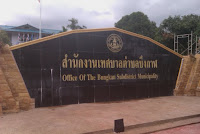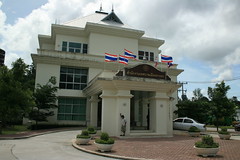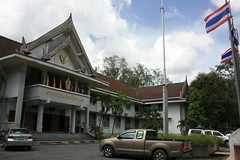The long-delayed municipal elections in Mae Sot finally took place on August 28. The term of the last council and mayor ended on January 28 already, and as it is usual in Thailand after the end of term new election are to be held within 60 days. But as the town was
upgraded to a city at this occasion, this meant that new constituencies had to be defined as there are now three instead of two constituencies which each send 6 councilors into the assembly. The problems with the
definition of the municipal borders further delayed the constituency definition, which were finally approved by the Election Commission on July 14 and
published in the Royal Gazette on August 27 - coincidentally one day before the election day.
It is apparently not a really big problem to extend the term of an elected body, or more correctly keep it in office as the acting local government after its end of term. In this case it were 212 days till the new election took place instead of the 60 day allowed by law. But if I am not mistaken, this isn't the longest time a local government stayed in office acting, as there are still some of the TAO upgraded in last year where no constituencies has been announced in the Royal Gazette by now.
Though I doubt any of my readers will know any of the local politicians in Mae Sot, I nevertheless present the full results here, which I
found in the online news site ryt9. They show very clearly that the local politics is quite different from the national one, as well as from the local politics in Bangkok. As seen in the
results of the Bangkok district elections, these elections are dominated by party politics, especially nowadays the two largest parties Phuea Thai and Democratic Party. However in most local elections, these parties pay no role at all, almost all winning candidates belong to a local party named City Development Group (กลุ่มพัฒนานครแม่สอด), only three independent candidates could win a seat.
First the mayor (นายกเทศมนตรี), where the incumbent Thoetkiat Chinsaranan (เทอดเกียรติ ชินสรนันท์) was the only candidate, and was elected with 8179 votes. In total, the voter turnout was almost 60%, the total number of eligible voters was 17,214, of which 10,321 did cast their vote. The 24 elected councilors are, hopefully correctly transcribed
- Constituency 1
Mr. Kun Khrueawira (นายกุล เครือวีระ), Mr. Sawai Mingoen (นายไสว มีเงิน), Mrs. Chan Chanta (นางจันทร์ จันตา), Mr. Chanthip Samutla (นายจันทร์ทิพย์ สมุทรหล้า), Banchong Madong (นายบรรจง มาคง), and independent candidate Mr. Phrasoet Howichit (นายประเสริฐ หอวิจิตร)
- Constituency 2
Mr. Anurak Tanta (นายอนุรักษ์ ตันตา), Mr. Pan Montip (นายปาน มนติ๊บ), Mr. Songkran Rueanchaidi (นายสงกรานต์ เรือนใจดี), Mr. Wasuthon Bunmak (นายวสุธร บุญมาก), Sakun Mekmok (นายสกุล เมฆหมอก), Mrs. Suwanna Khongkhanoi (นางสุวรรณา คงคาน้อย)
- Constituency 3
Mr. Ingkhrat Tantiphongsanti (นายอิงครัตน์ ตันติพงษ์ศานติ), Mr. Banchoet Lawanrattanakun (นายบรรเจิด ลาวัลย์รัตนากุล), Mr. Rankrit Kopraphakit (นายรณกฤต ก่อประภากิจ), Mr. Natthaphong Suthonwong (นายณัฐพงศ์ สุทรวงษ์), Mr. Napha Chokaewot (นางนภา ใจแก้วทิ) and independent Police Senior Sergeant Major (ด.ต.) Phrathip Sila (ประทีป สีลา)
- Constituency 4
Mr. Somchai Yakhamna (นายสมชัย ยะคำนะ), Mr. Yongyut Chatui (นายยงยุทธ จาตุย), Mr. Supphakon Saengrat (นายศุภกร แสงราช), Mr. Chumphon Chokhrua (นายชุมพล ใจครัว), Atsawin Phinitwong (นายอัศวิน พินิจวงษ์), and independent Mr. Suchetna Phetchaprani (นายสุเจตนา เพชรปราณี)
 |
Election poster of Manop Siphuegng,
courtesy 2bangkok |
A second local election took place last Sunday, the by-election of the president of the provincial administrative organization (PAO) of Nakhon Sawan. All of the PAO are currently around mid-term, so the next election should be in 2012, however on July 12 the PAO president
Amnat Sirichai (นายอำนาจ ศิริชัย) was assassinated and therefore the post was vacant. Four candidates run for the post, according to the still
inofficial results candidate number 1 Manop Siphueng (นายมานพ ศรีผึ้ง) did win by quite a big margin.
- Candidate 1: Manop Siphueng (นายมานพ ศรีผึ้ง), 207,850 votes
- Candidate 2: Chamroen Padwai (ร.ต.ต.จำเริญ ปด้วย), 129,619 votes
- Candidate 3: 8,662 votes
- Candidate 4: 5,251 votes
















